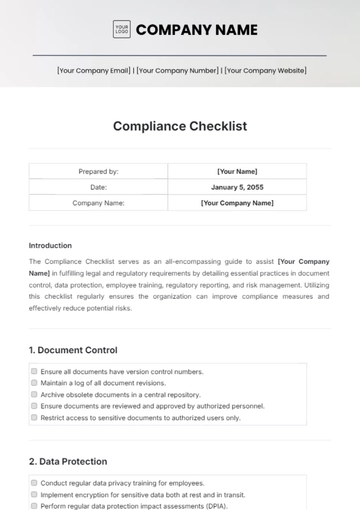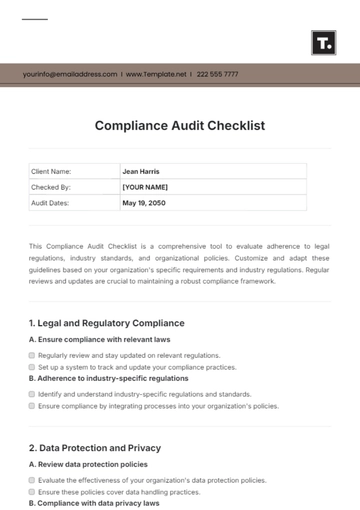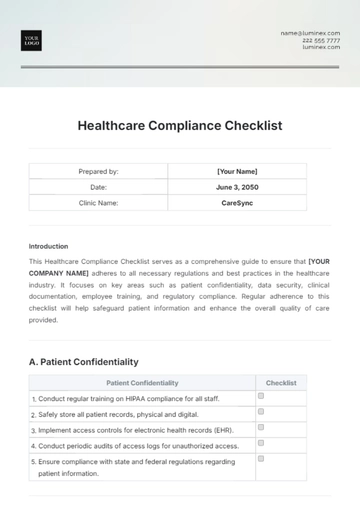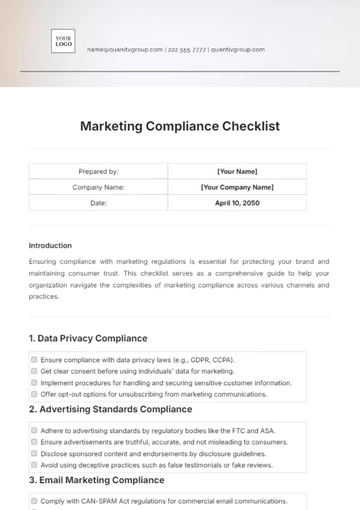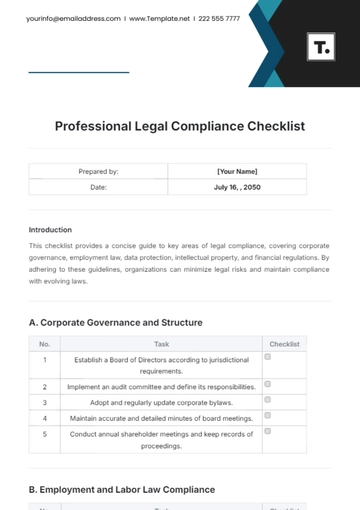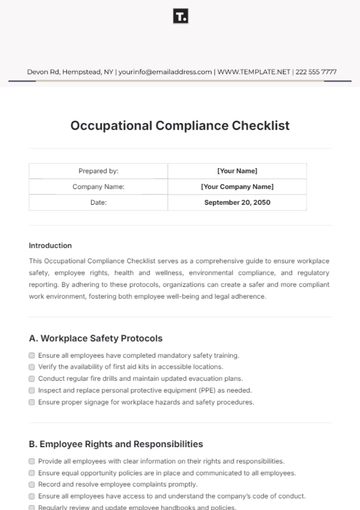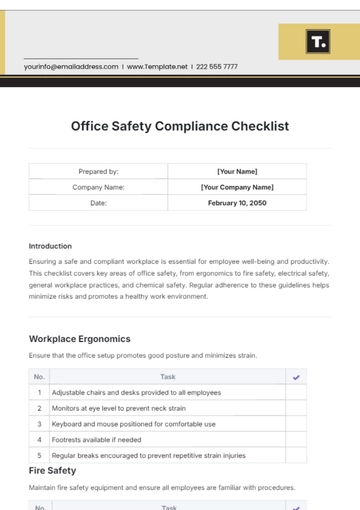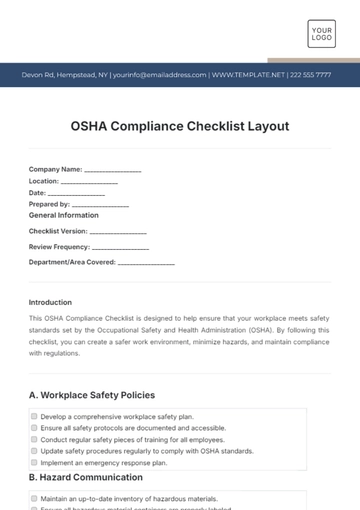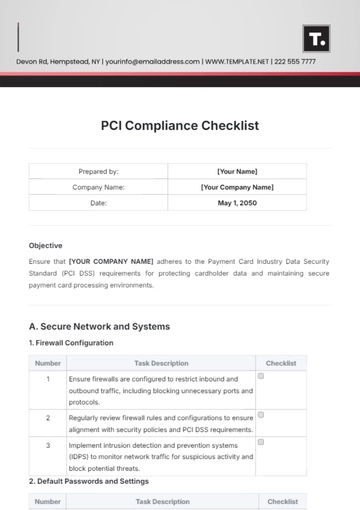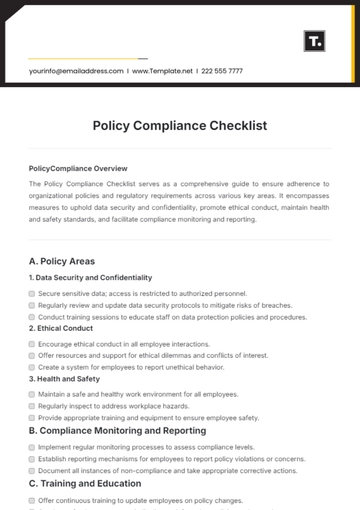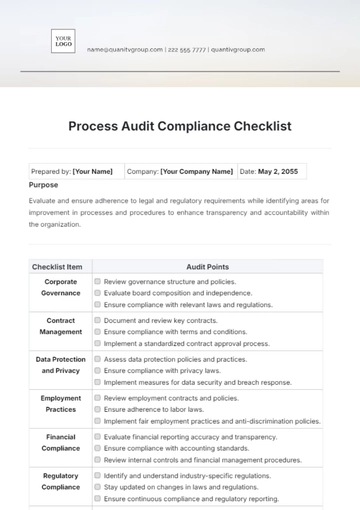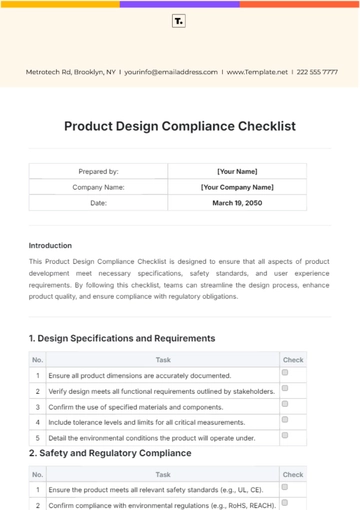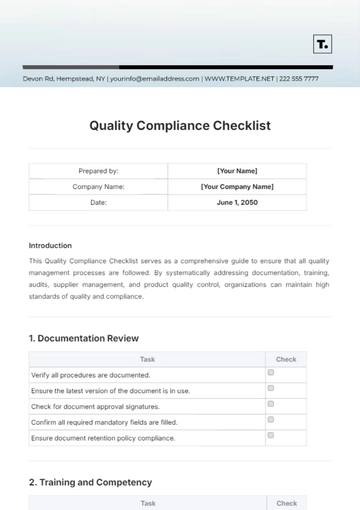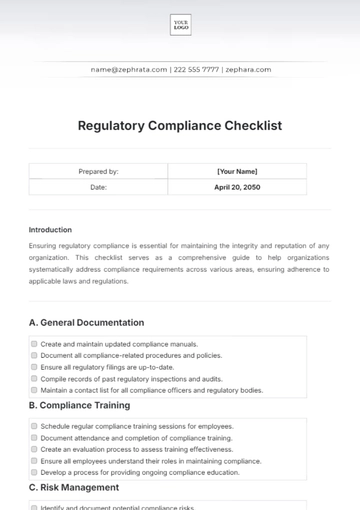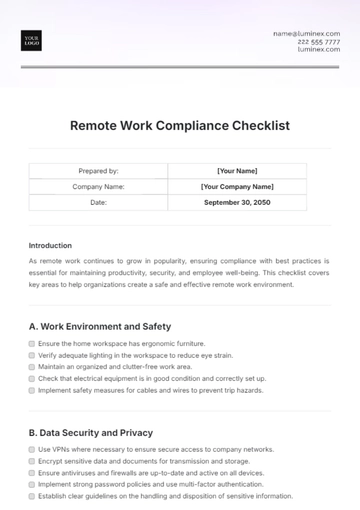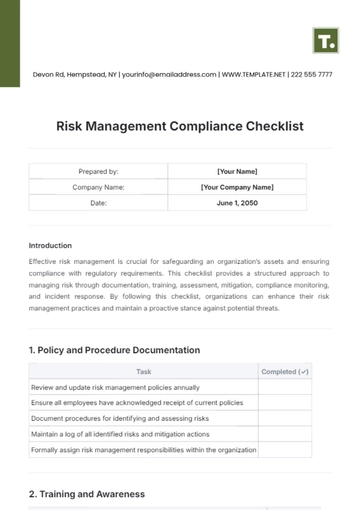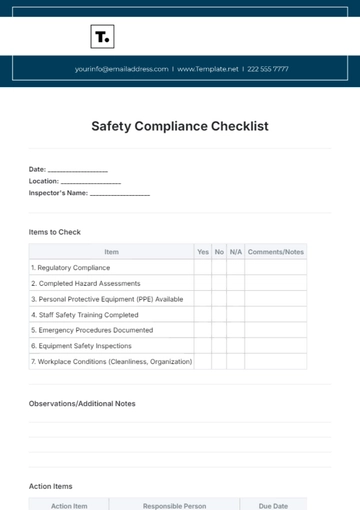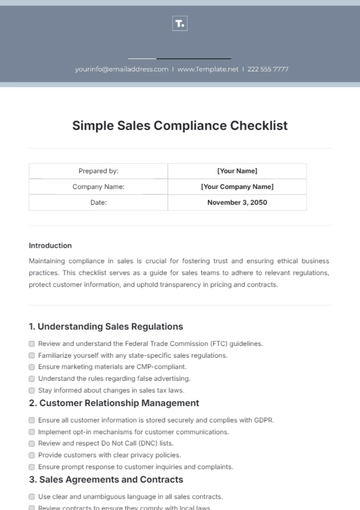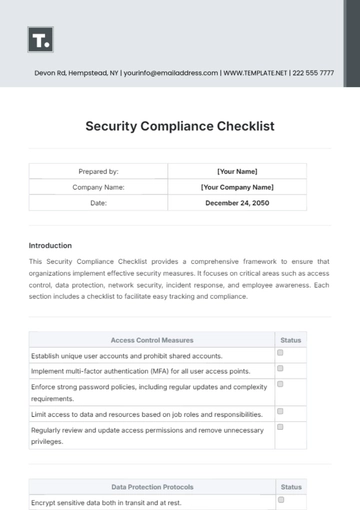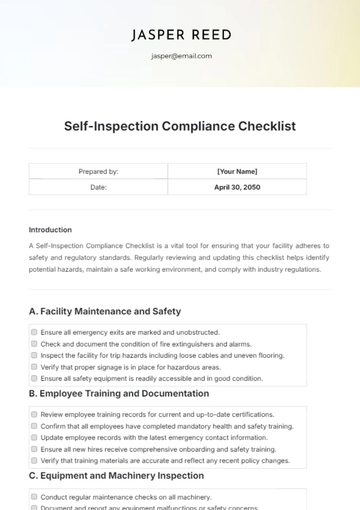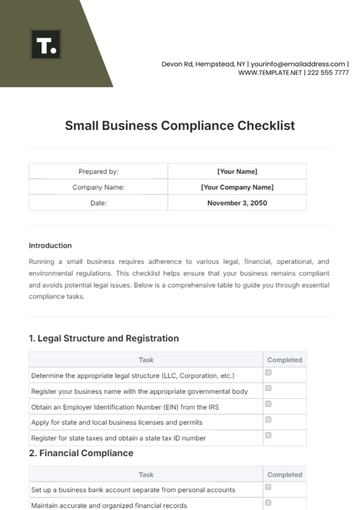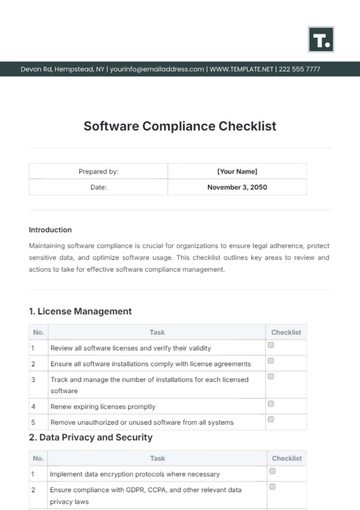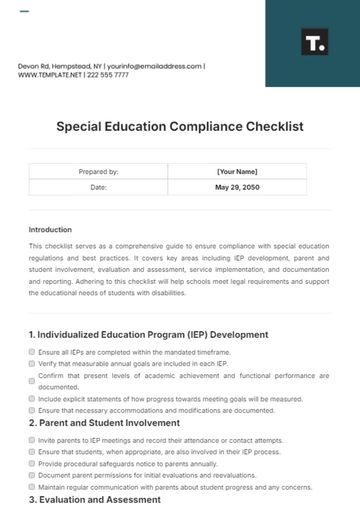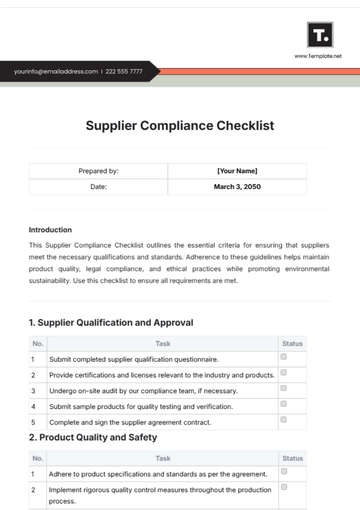Free GLBA Compliance Checklist

I. Compliance Overview
Objective: Ensure that [YOUR COMPANY NAME] adheres to the Gramm-Leach-Bliley Act (GLBA) requirements for safeguarding customer information and promoting data privacy and security in the financial services industry.
Responsible Party: [YOUR NAME], Compliance Officer
Date of Last Review: [DATE]
Next Scheduled Review: [NEXT REVIEW DATE]
II. Information Security Program
Risk Assessment:
Identify potential threats to customer information, including cyberattacks, data breaches, and employee errors.
Assess the likelihood and impact of each risk on customer data security and confidentiality.
Prioritize risks based on severity and likelihood to focus mitigation efforts effectively.
Regularly review and update risk assessments to adapt to evolving threats and business conditions.
Security Policies and Procedures:
Develop comprehensive policies governing the handling, storage, and disposal of customer information.
Define clear roles and responsibilities for employees regarding compliance with security measures.
Communicate policies through training and awareness campaigns to ensure understanding and adherence.
Regularly review and update policies to align with changing technology and regulatory requirements.
Access Controls:
Implement user authentication mechanisms like strong passwords or biometric verification.
Encrypt sensitive customer data during transmission and storage to prevent unauthorized access.
Apply role-based access controls to limit data access based on users' roles and responsibilities.
Monitor access and conduct regular audits to detect and prevent unauthorized access attempts.
III. Data Privacy and Confidentiality
Privacy Policy:
Develop and maintain a comprehensive privacy policy detailing data collection, storage, and sharing practices.
Provide the privacy policy to customers upon request and make it easily accessible on the company website.
Regularly review and update the privacy policy to reflect changes in data handling practices or regulatory requirements.
Communicate any updates or changes to the privacy policy to customers through email or website notifications.
Data Encryption:
Implement encryption protocols to safeguard sensitive customer information during transmission over networks.
Encrypt data stored in databases and on devices to protect against unauthorized access in case of security breaches.
Use encryption algorithms and secure key management practices to ensure data remains protected from cyber threats.
Regularly audit encryption measures to ensure compliance with security standards and mitigate vulnerabilities.
Data Minimization:
Establish data minimization policies to limit the collection and retention of customer information to only what is necessary.
Obtain explicit consent from customers before collecting any personal data and clearly communicate the purpose of data collection.
Regularly review stored data and delete any information that is no longer necessary for business purposes or legal compliance.
Train employees on data minimization principles and ensure compliance with policies through regular audits and monitoring.
IV. Employee Training and Awareness
Security Awareness Training:
Conduct regular training sessions to educate employees on GLBA regulations and their role in protecting customer information.
Cover topics such as phishing awareness, password security, and secure data handling practices during training sessions.
Provide resources such as online modules, newsletters, and posters to reinforce security awareness principles.
Test employee knowledge through quizzes or simulations to assess comprehension and identify areas for improvement.
Employee Background Checks:
Implement a thorough background check process for employees with access to sensitive customer information.
Verify employment history, criminal records, and references to ensure candidates meet security clearance requirements.
Conduct periodic rechecks for employees with ongoing access to customer data to maintain trust and compliance.
Document background check results and maintain records securely in accordance with GLBA requirements and company policies.
V. Vendor Management
Vendor Due Diligence:
Establish a process for assessing the security practices and controls of third-party vendors.
Evaluate vendors' security protocols, data handling procedures, and incident response capabilities.
Verify vendors' compliance with industry standards and regulatory requirements related to data security.
Regularly review and update due diligence assessments to address evolving security risks and vendor relationships.
Vendor Contracts:
Include clauses in vendor contracts specifying compliance with GLBA regulations and protection of customer information.
Define security requirements, data handling procedures, and incident response protocols in vendor agreements.
Require vendors to notify the company of any security incidents or breaches involving customer data.
Conduct periodic reviews of vendor contracts to ensure ongoing compliance with security and confidentiality obligations.
VI. Incident Response and Reporting
Incident Response Plan:
Create a comprehensive incident response plan outlining procedures for detecting, assessing, and responding to security incidents.
Designate a response team with clear roles and responsibilities for managing incidents and coordinating response efforts.
Define escalation procedures, communication protocols, and notification requirements for different types of incidents.
Regularly test and update the incident response plan to ensure effectiveness and alignment with evolving threats and regulations.
Incident Reporting:
Establish clear procedures for reporting security incidents to regulatory authorities, such as the FTC or state attorneys general, as required by data breach notification laws.
Notify affected individuals promptly in the event of a data breach or unauthorized disclosure of customer information, providing details on the incident and mitigation steps.
Document incident response activities, including investigation findings, containment measures, and remediation efforts, for regulatory compliance and internal review.
Conduct post-incident reviews to identify lessons learned and areas for improvement in incident response procedures and controls.
VII. Compliance Monitoring and Auditing
Compliance Monitoring:
Establish procedures for regular monitoring of security controls, data handling practices, and policy adherence to maintain GLBA compliance.
Conduct periodic audits and assessments of internal processes and controls to identify gaps or deficiencies in compliance.
Monitor changes in regulations and industry standards to ensure ongoing alignment with GLBA requirements.
Implement corrective actions and remediation plans to address any non-compliance issues identified during monitoring activities.
External Audits:
Engage qualified third-party auditors to perform independent audits of [YOUR COMPANY NAME]'s GLBA compliance program.
Provide auditors with access to relevant documentation, systems, and personnel to facilitate comprehensive audits.
Address any findings or recommendations from external audits promptly and implement corrective actions as necessary.
Use audit reports as a tool for continuous improvement of the GLBA compliance program and to demonstrate accountability to stakeholders.
VIII. Continuous Improvement
Regulatory Updates:
Monitor regulatory announcements, guidance documents, and enforcement actions from regulatory authorities such as the FTC and FFIEC to stay informed about changes to GLBA requirements.
Subscribe to industry newsletters, participate in relevant forums or conferences, and engage with industry associations to stay abreast of regulatory developments.
Conduct regular reviews of compliance practices and policies to ensure alignment with updated GLBA regulations and interpretations.
Train relevant personnel on new or revised GLBA requirements and their implications for business operations and compliance efforts.
Risk Management:
Conduct regular risk assessments to identify potential threats to the security and privacy of customer information, considering factors such as emerging technologies, evolving cyber threats, and changes in business operations.
Prioritize identified risks based on their likelihood and potential impact on customer information security and privacy, and develop mitigation strategies to address them.
Implement security controls and safeguards to mitigate identified risks, such as encryption, access controls, intrusion detection systems, and employee training programs.
Continuously monitor and review risk mitigation efforts, update risk assessments as necessary, and adjust security measures to address changes in the threat landscape or business environment.
IX. Signature
By signing below, you acknowledge that you have reviewed and understand the contents of this GLBA compliance checklist and affirm [YOUR COMPANY NAME]'s commitment to safeguarding customer information and complying with GLBA requirements.

Compliance Officer
[YOUR COMPANY NAME]
Date: [DATE]
- 100% Customizable, free editor
- Access 1 Million+ Templates, photo’s & graphics
- Download or share as a template
- Click and replace photos, graphics, text, backgrounds
- Resize, crop, AI write & more
- Access advanced editor
Ensure your business is GLBA compliant with our GLBA Compliance Checklist Template from Template.net. This editable and customizable tool streamlines your compliance process. Effortlessly tailor it to your specific needs using our Ai Editor Tool. Stay on top of your regulatory requirements with ease.
You may also like
- Cleaning Checklist
- Daily Checklist
- Travel Checklist
- Self Care Checklist
- Risk Assessment Checklist
- Onboarding Checklist
- Quality Checklist
- Compliance Checklist
- Audit Checklist
- Registry Checklist
- HR Checklist
- Restaurant Checklist
- Checklist Layout
- Creative Checklist
- Sales Checklist
- Construction Checklist
- Task Checklist
- Professional Checklist
- Hotel Checklist
- Employee Checklist
- Moving Checklist
- Marketing Checklist
- Accounting Checklist
- Camping Checklist
- Packing Checklist
- Real Estate Checklist
- Cleaning Checklist Service
- New Employee Checklist
- Food Checklist
- Home Inspection Checklist
- Advertising Checklist
- Event Checklist
- SEO Checklist
- Assessment Checklist
- Inspection Checklist
- Baby Registry Checklist
- Induction Checklist
- Employee Training Checklist
- Medical Checklist
- Safety Checklist
- Site Checklist
- Job Checklist
- Service Checklist
- Nanny Checklist
- Building Checklist
- Work Checklist
- Office Checklist
- Training Checklist
- Website Checklist
- IT and Software Checklist
- Performance Checklist
- Project Checklist
- Startup Checklist
- Education Checklist
- Home Checklist
- School Checklist
- Maintenance Checklist
- Planning Checklist
- Manager Checklist
- Wedding Checklist
- Vehicle Checklist
- Travel Agency Checklist
- Vehicle Inspection Checklist
- Interior Design Checklist
- Backpacking Checklist
- Business Checklist
- Legal Checklist
- Nursing Home Checklist
- Weekly Checklist
- Recruitment Checklist
- Salon Checklist
- Baby Checklist
- Equipment Checklist
- Trade Show Checklist
- Party Checklist
- Hospital Bag Checklist
- Evaluation Checklist
- Agency Checklist
- First Apartment Checklist
- Hiring Checklist
- Opening Checklist
- Small Business Checklist
- Rental Checklist
- College Dorm Checklist
- New Puppy Checklist
- University Checklist
- Building Maintenance Checklist
- Work From Home Checklist
- Student Checklist
- Application Checklist
